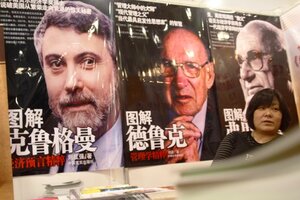Don't understand the economy? It's not your fault.
Even economists don't fully understand the complicated global economy.
.

A businesswoman sits by posters promoting books on Paul Krugman, Peter F. Drucker, and Milton Friedman, at the national books trade fair in Jinan in east China's Shandong province in 2009. Unfortunately, economic theories can't fully be tested because of political and other constraints, which means debates will keep raging over what really works.
Guo Qing/FeatureChina/Newscom/File
Why is it that economists don't understand – at a deep and scientific level – how the economy works?
Two centuries after Adam Smith's "Wealth of Nations," and more than seven decades after the Great Depression, they're still fighting over what works and what doesn't. The debate is far from theoretical. The fate of nations, politicians, and millions of working people depends on policymakers getting it right.
Right now, the big debate in Washington is on how to speed up the recovery so as to shrink unemployment and boost revenues. To help, policymakers are poised to extend Bush tax cuts for a year or two – an echo of the theories of John Maynard Keynes, who argued that in recessions governments should spend money to keep the economy moving, even if it piles up debt.
Using a different theory, the Federal Reserve is embarked on a new round of "quantitative easing" – the purchase of $600 billion in Treasury securities over the next eight months. The idea, built on the money supply theories of Milton Friedman, is that by pumping lots of money into the economy during times of recession, central banks can keep things from getting worse. Who's right?
In 1970, I wrote a Monitor column asserting that Dr. Friedman's "monetarist" school of economic thought was "winning more and more converts" because its advocates' forecasts for the American economy had been more accurate than predictions of Keynesian economists. It was seen then as a "revolution" in economist thinking.
Lately, though, some monetarists are having second thoughts.
Growth in the nation's money supply "doesn't predict [the economy] as well as it used to," says Paul Kasriel, research director of Northern Trust Co. in Chicago. Mr. Kasriel, who won a top accuracy award for his economic forecasts in the years 2002 to 2005, says he renounced monetarism a couple of months ago.
Now Kasriel uses a different forecasting tool – growth in bank credit and Federal Reserve credit, rather than the money supply. During the first Fed quantitative easing (dubbed QE1), from November 2008 to March 2010, the central bank bought $1.8 trillion of government securities in order to reduce interest rates and add money to the financial system. The Fed, as economic students are told, can create new money "out of thin air." But the effect of QE1 was negated because instead of lending the money, banks held onto it, building up cautionary reserves, he says.
The extra $600 billion in QE2 is a different story. Kasriel calculates it should boost credit by 5.2 percent. The US output of goods and services should grow a modest 3 percent next year, he predicts. That's better than a renewed slump, he says.
Other forecasters, employing monetarist theory, say QE will fan damaging inflation.
The main reason that economists can't agree is that economics is not an exact science.
The data are rough. The system is dynamic, so a shift in regulation or policy can mean big changes. Economic theories can't be tested by precise, controlled policy experiments when the fate of a national economy is at stake.
So macroeconomists – who look at a national economy as a whole – usually work with "some sort of synthesis" between the theories of Keynes and Friedman, says Simon Johnson, an economist at the Massachusetts Institute of Technology.
And economists will continue their debates over economic theory. It's a "never-ending process," says Professor Johnson.
• David R. Francis writes a weekly column.
